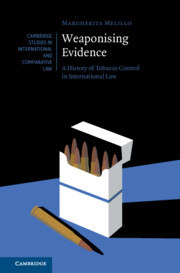Book contents
- Weaponising Evidence
- Cambridge Studies in International and Comparative Law: 183
- Weaponising Evidence
- Copyright page
- Contents
- Acknowledgements
- Chronology
- Table of Cases
- Table of Treaties
- Abbreviations
- 1 Introduction
- 2 The Negotiation of the WHO Framework Convention on Tobacco Control
- 3 The Activities of the FCTC Conference of the Parties
- 4 Philip Morris v Uruguay (ICSID) and Australia – Plain Packaging (WTO)
- 5 Conclusions
- Annex List of Interviewees
- Index
- Cambridge Studies in International and Comparative Law
1 - Introduction
Lawfare and Evidence in the International Law on Tobacco Control
Published online by Cambridge University Press: 11 January 2024
- Weaponising Evidence
- Cambridge Studies in International and Comparative Law: 183
- Weaponising Evidence
- Copyright page
- Contents
- Acknowledgements
- Chronology
- Table of Cases
- Table of Treaties
- Abbreviations
- 1 Introduction
- 2 The Negotiation of the WHO Framework Convention on Tobacco Control
- 3 The Activities of the FCTC Conference of the Parties
- 4 Philip Morris v Uruguay (ICSID) and Australia – Plain Packaging (WTO)
- 5 Conclusions
- Annex List of Interviewees
- Index
- Cambridge Studies in International and Comparative Law
Summary
Chapter 1 sets the historical and theoretical background of the book. It starts by describing the regulatory battles that took place from the 1970s to adopt more stringent tobacco control measures. Then, it illustrates how the negotiations of the WHO Framework Convention on Tobacco Control and the subsequent WTO and international investment disputes can be considered the internationalisation of the tobacco wars. In this context, the concept of ‘lawfare’ is introduced as a descriptive device and analytical tool for the analysis of the book. The second part of the introduction introduces the second fil rouge of the book: evidence. It begins by defining the notion of evidence and by showing how, in the context of tobacco control, it can refer to different bodies of evidence that pertain both to the risk assessment and risk management dimension of tobacco control measures. This second part, moreover, shows how evidence has always been one of the key points of contention in the tobacco wars and has continued to be so in the international tobacco control lawfare. The introduction concludes with an explanation of the methodology employed, a reflection on its limits, and an outline of the content of the book.
Keywords
- Type
- Chapter
- Information
- Weaponising EvidenceA History of Tobacco Control in International Law, pp. 1 - 30Publisher: Cambridge University PressPrint publication year: 2024

